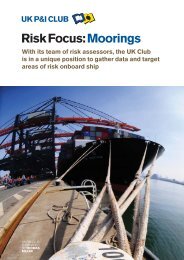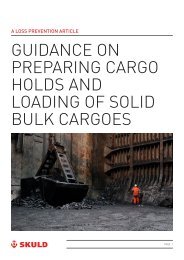You also want an ePaper? Increase the reach of your titles
YUMPU automatically turns print PDFs into web optimized ePapers that Google loves.
<strong>ECSA</strong><br />
<strong>The</strong> <strong>Tramp</strong> <strong>Shipping</strong> <strong><strong>Mar</strong>ket</strong><br />
2. <strong>The</strong> product provided by the shipping industry<br />
2.1 <strong>The</strong> transport service<br />
Over the last decade shipping has been one of the fastest growing sectors of the global economy.<br />
In 2014 the shipping industry transported 10.5 billion tons of cargo, 69% more than in 2003 when<br />
6.2 billion tonnes was shipped. This cargo was carried by a deep sea cargo fleet (including bulk,<br />
specialised and liner) of over 53,000 ships. During the decade $1 trillion was invested in tankers;<br />
bulk carriers, containerships and gas tankers 4 . Europe remains the leading shipowner with a 36%<br />
share of the gross tonnage of shipping and investment committed of $41 billion accounted for<br />
40% of the global total.<br />
<strong>The</strong> wider fleet of vessels of 100 GT and above, including non-cargo vessels, stands at just under<br />
90,000 ships. Another 30,000 service vessels are engaged in fishing, research, port services and<br />
the offshore industry. <strong>The</strong> annual investment in new ships in 2014 was $101 billion, with another<br />
$26 billion spent on second-hand ships.<br />
With the exception of the cruise and ferry businesses, shipping serves industrial customers not<br />
consumers. <strong>The</strong> clients include large corporations like oil companies, chemical companies, steel<br />
mills, car manufacturers, sugar refiners, traders and a host of other manufacturing companies<br />
which source raw materials and distribute their products in the international market. <strong>The</strong> product<br />
sold is sea transport.<br />
2.2 <strong>The</strong> commodities traded by sea<br />
<strong>The</strong> shipping industry transports everything from a 3 million barrel parcel of oil to a cardboard<br />
box of Christmas gifts. <strong>The</strong> main seaborne commodity trades are shown in Figure 1 arranged into<br />
five groups reflecting the area of economic activity to which they are most closely related. <strong>The</strong>se<br />
groups can be summarized as follows:<br />
1. Energy trades: Energy dominates bulk shipping. This group of commodities, which<br />
accounts for 38% of seaborne trade, comprises crude oil, oil products, liquefied gas and<br />
thermal coal for use in generating electricity.<br />
2. Metal industry trades: This major commodity group, which accounts for around 25% of<br />
sea trade, including raw materials and products of the steel and non-ferrous metal<br />
industries, including iron ore, metallurgical grade coal, non-ferrous metal ores, steel<br />
products and scrap.<br />
3. Agricultural trades: <strong>The</strong> products or raw materials of the agricultural industry. <strong>The</strong>y<br />
include cereals such as wheat and barley, animal feedstuffs, sugar, molasses, refrigerated<br />
food, forest products, oil and fats and fertilizers.<br />
4. Container cargoes: This category covers a wide range of manufactures such as textiles,<br />
machinery, capital goods, vehicles, consumer goods, etc, as well as semi-finished<br />
industrial products. <strong>The</strong> total tonnage involved in this sector accounts for around 15% of<br />
sea trade, but many of these commodities have a high value so their share in value is<br />
probably closer to 50 per cent. <strong>The</strong>y are the mainstay of the liner trades and their impact<br />
upon the shipping industry is much greater than the tonnage suggests.<br />
5. Other industrial materials: <strong>The</strong>re are a wide range of industrial materials such as cement,<br />
salt, gypsum, mineral sands, alumina, chemicals and many others. <strong>The</strong> total trade in these<br />
commodities accounted for 12% of sea trade. <strong>The</strong>y cover a whole range of industries.<br />
4 Investment by sector was tankers $262 bn; bulk carriers $381 bn; gas $114 bn and containerships $229 bn<br />
Clarkson Research Services Limited 11 <strong>Mar</strong>ch <strong>2015</strong>




